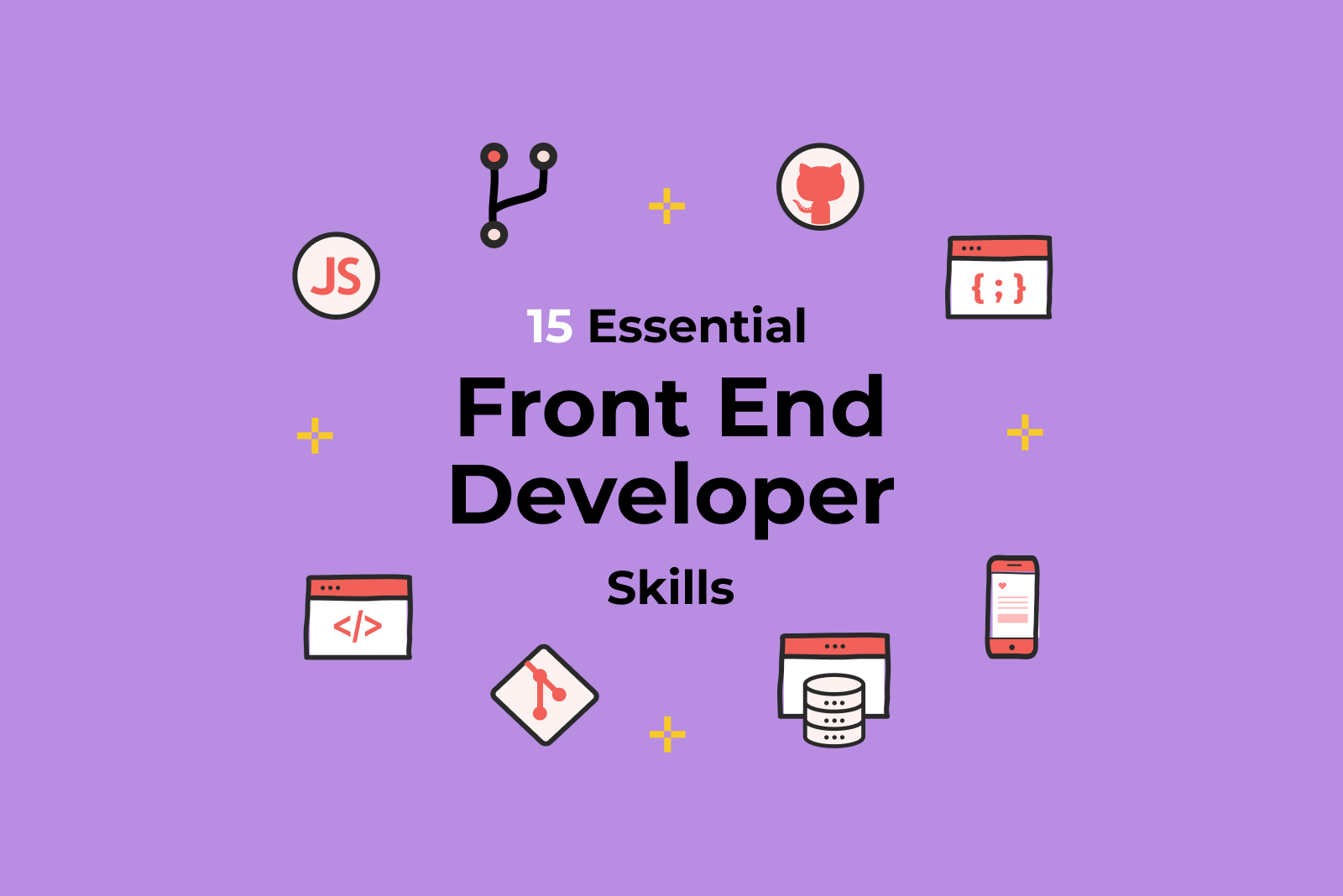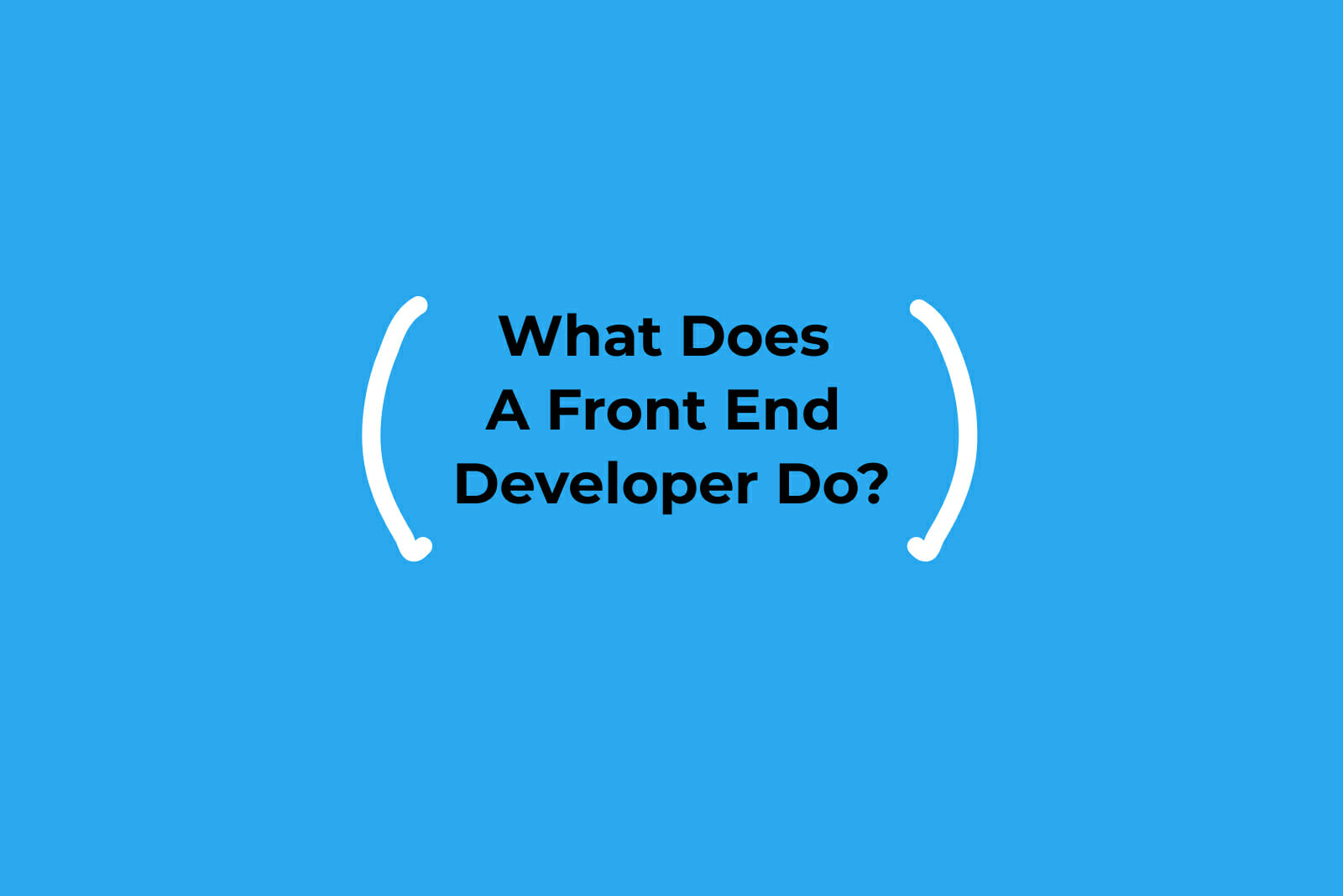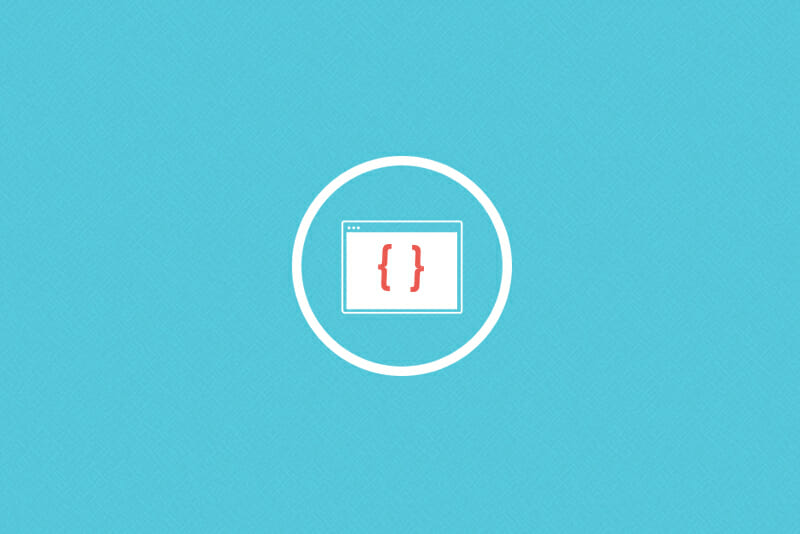The 15 Essential Front End Developer Skills in 2024—Plus Expert Insights!
Want to become a front end developer? Here are the 15 essential technical and non-technical skills you need to know, according our review of 100s of job listings, plus insight from the experts!

Are you interested in what skills you need to know to work as a front end developer? You’ve come to the right place! Here you will take a deep dive into the 15 key skills required for all professional front end developers.
But before we get into the nitty gritty, let’s just make sure we’re all on the same (web)page here: front end developers are a type of web developer that write code for the front-end of websites, meaning those parts that you and I interact with when we visit websites.
That’s right, everything you’re looking at right this second was made possible by a front end web developer—was some of it supported by a backend or full stack developer? Sure! But ultimately, the look and feel and interaction of this website was made possible by a front end developer and for their hard work we are so thankful!
If you are considering a career change into front end development, you’d be smart to do so. Front end development is a great starting point for career changers because the barrier to entry is relatively low (no prior experience or computer science degree required), annual salaries are high (over $100,000 according to the website Indeed) and the growth of web developers, which includes front end developers, is high (double the average of all jobs according to the BLS).
Plus, this is a job that requires a lot of creativity and problem solving skills, and most importantly: a deep and abiding passion for the web. All traits I trust that you have.
To put together this guide we read hundreds of front end developer, front end engineer, junior web developer, and web developer job listings and consulted many frontend development experts. Below you will find information about the key technical skills you need to know in order to successfully land a job as an entry-level front end developer.
Short on Time And Want Just The 5 MOST Important Skills?
Then check out this video where Skillcrush founder and CEO, Adda Birnir, reviews the five MOST essential front end skills for career changers:
Table of Contents
The 15 Essential Skills You Need to Become a Front End Developer
- HTML
- CSS
- JavaScript
- jQuery
- JavaScript Frameworks
- Front End Frameworks
- CSS Preprocessors
- RESTful Services/APIs
- Responsive/Mobile Design
- Cross-Browser Development
- Content Management Systems
- Web Accessibility
- Testing/Debugging
- Git/Version Control
- Problem-Solving
How to Land a New Job in Front End Development in 12 Months or Less

The 15 Essential Front End Developer Skills You Need To Know
To begin, would you believe me that front end web developers use only three coding languages to code all the websites and web apps in the world? It’s true! And those three coding languages are: HTML, CSS and JavaScript. And as you might guess, they’re the very first skills you need to learn:
1. HTML
HTML (Hyper Text Markup Language) is the most basic building block of the web. Think how the atom is to all particulate matter, that’s how HTML is to every webpage that has ever existed.
HTML and the web were literally created together, as one: in 1989 computer scientist Tim Berners-Lee invented HTML and at the same time invented a web browser which allowed people to read HTML documents all over the world!
Now, almost 40 years later, when any front end developer decides to code up a web page the first thing they have to do is write the HTML. Of course, HTML has come a long way in 40 years and you’ll be writing a fancy version of HTML called HTML5.
Fundamentally, the purpose of HTML is to organize content in a way that makes sense to computers, and since computers don’t understand much you have to tag every piece of content with its appropriate HTML tag (paragraphs get <p> tags, headlines get <h1>, <h2>, or <h3> tags, images get <img> tags, etc.).
2. CSS
Now you might notice that although impressive, the first website ever created was quite boring to look at. This is where CSS (Cascading Style Sheets) comes in. CSS is the coding language used to turn that boring HTML into the beautiful websites that you know and love, but it does so in a very important way: without cluttering up your HTML!
As Eric Meyer, one of the foremost experts on CSS, first described way back in 2000:
“That’s why CSS is so important. Finally, not only do we have the ability to describe sophisticated presentation, we can do it in relation to well-structured, uncluttered documents.”
Now, like HTML, CSS has come a long way since it was first invented in 1996, and nowadays you’ll be writing CSS3. In addition to all the colors and beautiful fonts and animations you’ve come to know and love, CSS3 makes building responsive layouts easier than ever.
In order to start on any front end web development career path, you’ll have to master coding with HTML and CSS. The good news is that getting a solid working knowledge of either of these can be done in just a few weeks (and you can even start today in our free online coding course).
And the kicker for all of this is that HTML and CSS are actually all you technically need to build beautiful websites.
But in order to truly realize your destiny as a professional, six-figure commanding front end developer, you’ve got one more coding language to learn:

3. JavaScript
JavaScript is a programming language that takes your HTML and CSS and cranks that sh*t up!
Virtually anything fancy and interactive you can think of on the web is powered by JavaScript: video players, infinite scroll, real-time refreshing, date pickers in form fields, maps where you can zoom in and out, online games, in-page chat, the list goes on and on.
JavaScript is the only programming language that is used on the front end of websites, making it the most popular programming language in the world as David Flanagan describes in the introduction to his book, JavaScript: The Definitive Guide: Master the World’s Most-Used Programming Language:
“JavaScript is the programming language of the web. The overwhelming majority of websites use JavaScript, and all modern web browsers—on desktops, tablets, and phones—include JavaScript interpreters, making JavaScript the most-deployed programming language in history.”
4. jQuery
While we’re talking JavaScript, I would be remiss not to mention jQuery.
JQuery is a JavaScript library, a collection of plugins and extensions that makes developing with JavaScript faster and easier. In other words: we’re talking more functionality with fewer lines of code.
For example, here’s the code for hiding a button in JavaScript*:
document.getElementById("mybutton").classList.add("hide");Here’s that same code written in jQuery:
$("#mybutton").hide();jQuery, the e.b. white of JavaScript programming*
Rather than having to code everything from scratch, jQuery lets a developer add ready-made elements to projects, then customize as necessary. You can use jQuery to perform common JavaScript functions like adding or removing classes, or to build common web UI elements like countdown timers, date pickers, or tooltips.
* e.b. white was an American author in the early 20th century known for his plain and simple style of writing.
5. JavaScript Frameworks
JavaScript frameworks give a ready-made structure to your JavaScript code. There are different types of JavaScript-based frameworks for different needs, though AngularJS, Backbone, Ember, Vue.js, and React are the most popular ones.
JavaScript frameworks are a big topic, and the advent of the JavaScript framework age post 2010 has profoundly shaped the development of the entire front end developer profession, and the web at large.
Fundamentally, the purpose of JavaScript frameworks is to speed up development. They can also be used with libraries like jQuery to truly keep the amount of from-scratch coding you have to do to an absolute minimum. This makes it possible to build significantly bigger and more robust applications and JS frameworks have played a pivotal role in the creation of increasingly more complex web applications (think incredibly interactive websites like Figma or Slack).
Picking which framework to focus your efforts on learning first is a topic developers love to debate, but our opinion is that the biggest bang for your buck is with ReactJS.
6. Git and Version Control Systems
Version control systems let you keep track of changes that have been made to code. They also make it easy to revert to an earlier version if you screw something up. Think: track changes in Word, but for code.
The other, less obvious to the layman, use for version control is when you’re working on a team. In fact, you wouldn’t be allowed to touch a single line of code in any professional development environment without using a version control system. That way you, and the 100, or 1,000 closest developer colleagues can all work on the same codebase, at the same time, without worrying about overwriting each other’s work.
Git is the most widely used of these version control management systems. Knowing how to use Git is going to be a requirement for virtually any development job. This is one of those vital job skills that web developers need to have but few actually talk about. So git on it!
7. Front End Frameworks
About now you are no doubt starting to pick up on a theme: front end development skills 4-14 are all about how to optimize your work for web performance, aka how to write faster code faster (and better).
And CSS and front end frameworks are here to help! They do for CSS what JavaScript frameworks do for JavaScript: they give you a jumping-off point for faster coding.
Since so much CSS starts with the same elements from project to project (think: form fields, buttons, headlines), a framework that provides all of these for you upfront is super valuable.
Most front end developer job listings expect you to be familiar with how these frameworks work and how to use them, so you should definitely get a head start if you want to be a front end programmer or just to further hone your front end development skills.
8. CSS Preprocessors
Preprocessors are another tool that front end developers can use to speed up CSS coding. A CSS preprocessor adds extra functionality to CSS to make your CSS more scalable and easier to work with. In practice what this means is that you can do fancy programming language type things like use variables and do simple math, stuff that normal CSS can’t do.
The pre-processor then “processes” your code before you publish it to your website, and turns it into well-formatted and cross-browser friendly CSS.
Sass and LESS are the two most in-demand preprocessors.
9. RESTful Services and APIs
Without getting too in the weeds on this one, REST stands for Representational State Transfer. In basic terms, it’s a simple and standardized way—called “architecture”—for data to be shared between sources on the web. RESTful services and APIs are web services that adhere to REST architecture, they’re often shortened to just REST API.
While it all sounds really complicated and technical, it’s a simple set of guidelines and practices that sets expectations so you know how to communicate with a web app. The general process is the same for any service that uses RESTful APIs, only the data returned will be different.
Let’s say you wanted to write an app that shows you all of your social media friends in the order in which you became friends. You could make calls to Facebook’s RESTful API to read your friends list and return that data to your website where you could do what you wanted with it.
Although REST APIs are more commonly used by backend developers with backend languages like Python and Ruby and PHP, some REST APIs can also be used with JavaScript, making them available for front end development!

10. Responsive and Mobile Design
In the US alone, more people access the internet from their mobile device than from a desktop computer, so it’s no wonder that responsive and mobile design skills are super important to employers.
Mobile design means that the site’s layout (and sometimes functionality and content) changes based on the screen size and device someone is using.
For example, when you visit a website from a desktop computer with a big monitor, you’ll see multiple columns, big graphics, and interactions created specifically for mouse and keyboard users. On a mobile device, the same website would appear as a single column optimized for touch interaction, but using the same base files.
Responsive web design is a type of mobile design where the same codebase is used for both the web and mobile experience of a website. The benefits of this approach is that it can be easier to maintain since it’s one website that simply changes as the screen size changes. This approach was pioneered in 2010 by a developer named Ethan Marcotte, and he created this method in hopes of creating a simpler answer to the question he posed which was “But how can we—and our designs—adapt?” to the rapidly expanding device market.
The sample website Ethan Marcotte designed and built as a proof of concept for responsive web design.
(You can read his original blog post introducing responsive design on A List Apart, view the example website he built as a proof of concept, and check out the book he authored on the subject.)
11. Cross-Browser Development
Unfortunately for former Microsoft CEO, Steve Ballmer, very few developers would agree with his statement that he’d “rather use Windows and Internet Explorer in Hell than I’d use Linux and Mozilla Firefox in Heaven!”
In fact, one might argue that Internet Explorer, and its infamous wonkiness, was the main reason why developers the world over have spent so many years worrying about cross-browser development.
Modern browsers are getting pretty good at displaying websites consistently, but there are still differences in how they interpret code behind the scenes and what that can result in is that websites don’t look the same depending on what browser you’re using (e.g. Firefox vs. Chrome vs. Safari). Until all modern browsers work perfectly with web standards, knowing how to make each of them work the way you want them to is an important skill. That’s what cross-browser development is all about.
Read more about cross-browser compatibility on Wikipedia and or in the Mozilla Developer docs, or check out Daniel Herken’s Cross Browser Handbook for a deeper dive.
12. Web Accessibility
I bet you didn’t know that according to Section 508 of the Rehabilitation Act of 1973, all websites must be accessible to people with disabilities, did you? But what’s horrible is that it’s estimated that only 2% of websites meet Web Content Accessibility Guidelines (WCAG).
Not on your watch!
Building accessible websites means taking into consideration how to make your websites function when the user is dealing with a variety of different disabilities, such as not being able to see the website and needing to use a screenreader, or only being able to use a keyboard to navigate, as two common examples.
The good news is that although web accessibility is a big topic, it doesn’t have to be hard to implement. In fact, in her talk “Building Inclusive Experiences with CSS and SVGs” web accessibility expert Sara Soueidan says that there are a lot of “small tips for things you can do that will have a lot of impact on the user experience and usability of your interfaces and the accessibility as well.” These include thoughtful use of animations (and how to do it without making people sick), or making it possible for users to customize aspects of your site including type size and colors.
13. Content Management Systems and E-Commerce Platforms
Almost every website out there is built on a content management system (CMS). What content management systems do is make it easy for you to publish content to the web, such as a blog, or any larger website that has so much content on it that having the content live inside the code files isn’t viable.
Although front end developers would not build a CMS from scratch (that would be the work of backend developers) they can integrate their code with an existing CMS.
The most popular CMS worldwide is WordPress, which is behind the scenes of millions of websites (including this here Skillcrush blog!). In fact, almost 60% of websites that use a CMS use WordPress.
Other popular CMSs include Joomla, Drupal, and Magento. While lesser-used CMS knowledge isn’t as in-demand WordPress expertise, it can give you a niche desirable among companies who use different systems.
14. Testing and Debugging
It’s a fact of life for any technologist: bugs happen. Being familiar with testing and debugging processes is an essential skill.
Unit testing is the process of testing individual blocks of code, and unit testing frameworks provide a specific method and structure for doing so. The big idea with unit testing is that you write “tests” in code that test your other code, and you can do it with any programming language, including JavaScript.
Another common type of testing is UI testing (also called acceptance testing, browser testing, or functional testing), where you check to make sure that the website behaves as intended.
In UI testing you can write tests in code like with unit testing, but you can also just write test instructions that a normal human could run: aka “make sure that if a user forgets to fill out a required form field, your form error box pops up,” and that kind of thing.
Testing, ultimately, is less about how you write or perform the tests, and more about having a thorough and detail oriented way to make sure that new code changes don’t cause problems with the existing functionality of your site. Testing is a core part of quality assurance, often called QA.
Debugging is simply taking all of the “bugs” (errors) those tests uncover (or your users uncover once your site is launched), putting on your detective hat to figure out why and how they’re happening, and fixing the problem. Different companies use slightly different processes for this, but if you’ve used one, you can adapt to others pretty easily.
Because testing and debugging contribute in large part to a positive user experience, they’re valuable skills for a front end developer to know.
15. Problem-Solving Skills
If there’s one thing that all front end developers have to have, regardless of the job description or official title, it’s excellent problem-solving skills. From determining how to best implement a design using the best modern development methods to fixing bugs that crop up to figuring out how to make your front end code work with back end code, development is all about creative problem-solving.
For example, you’ve created a perfectly-functioning website front end and you hand it over to the back end developers for them to integrate it with the content management system (CMS). All of a sudden, half your awesome features stop working!
A good front end developer will view this as a puzzle to be solved rather than an absolute disaster. Of course, an excellent, senior-level front end developer will anticipate these problems and try to prevent them in the first place, but there’s plenty of time for that later!
Bonus Skill: Passion for the Web
Ultimately, the truth of all technology jobs is this: technology changes quickly!
Some of the skills mentioned here have stood the test of time (HTML and CSS and JavaScript are all over 30 years old), and some will inevitably fall by the wayside as everything else develops and changes.
That means that to stay relevant as a front end developer, you’ll have to be continuously learning new technologies, new techniques, and new skills. And that’s the joy of jobs in tech, even if you end up staying in one place, absolutely everything else will grow and change around you.
How to Land a New Job in Front End Development in 12 Months or Less
If you’re pumped about working as a front end developer but not sure where to get the skills, you’re in the right place!
Take a look at our guide on how to learn all the essential front end developer skills you need in as little as 6 months using the exact process we use to train our students in our Break Into Tech program. The Break Into Tech program includes access to our Front End Developer Career Track, a expertly designed career path that will give you all the skills you need to start working as a front end developer including a solid foundation in HTML and CSS, responsive web development, Git, and JavaScript, and access to our Get Hired, career coaching and job search program that’s guaranteed to land you your first job within 6 months of learning all the necessary skills.
And you can get started for today with our free coding class.
Scott Morris
Category: Blog, Entry Level Tech Jobs, Front End Developer, Learn to Code







